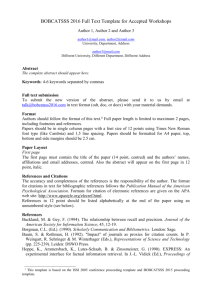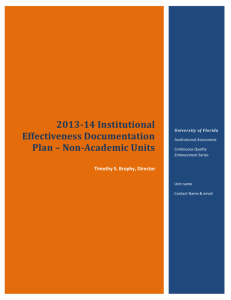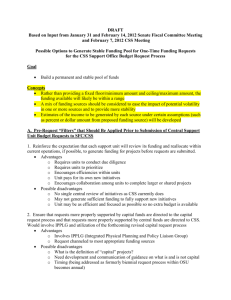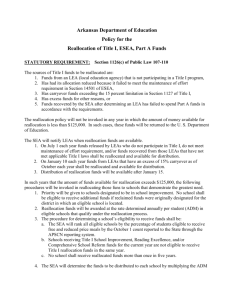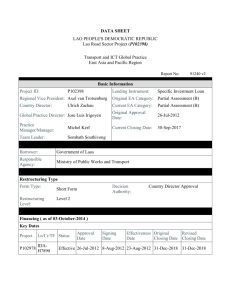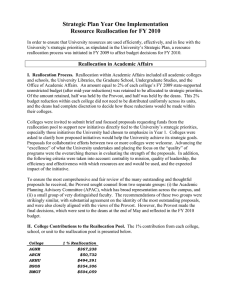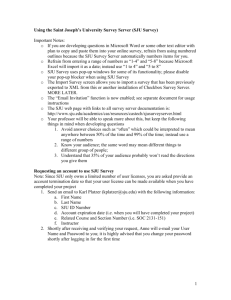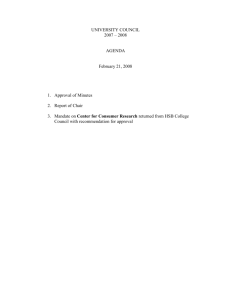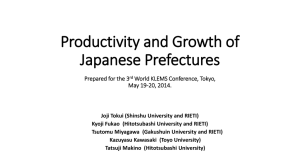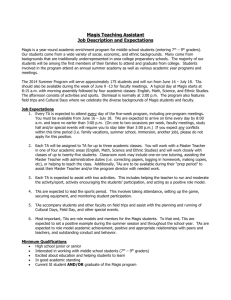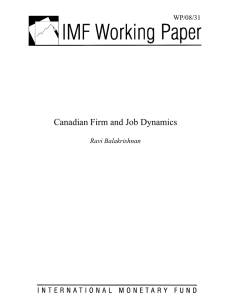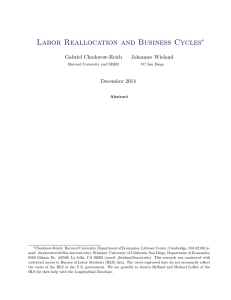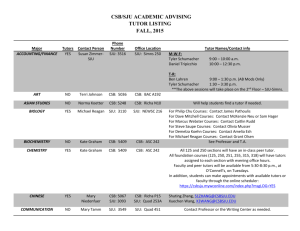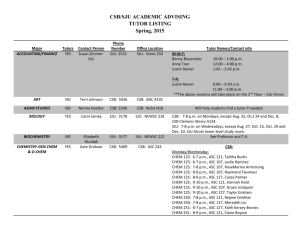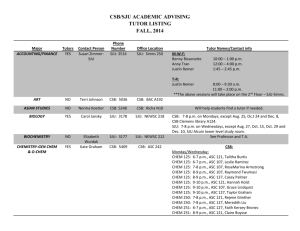Annual Report & Plan Template Instruction
advertisement
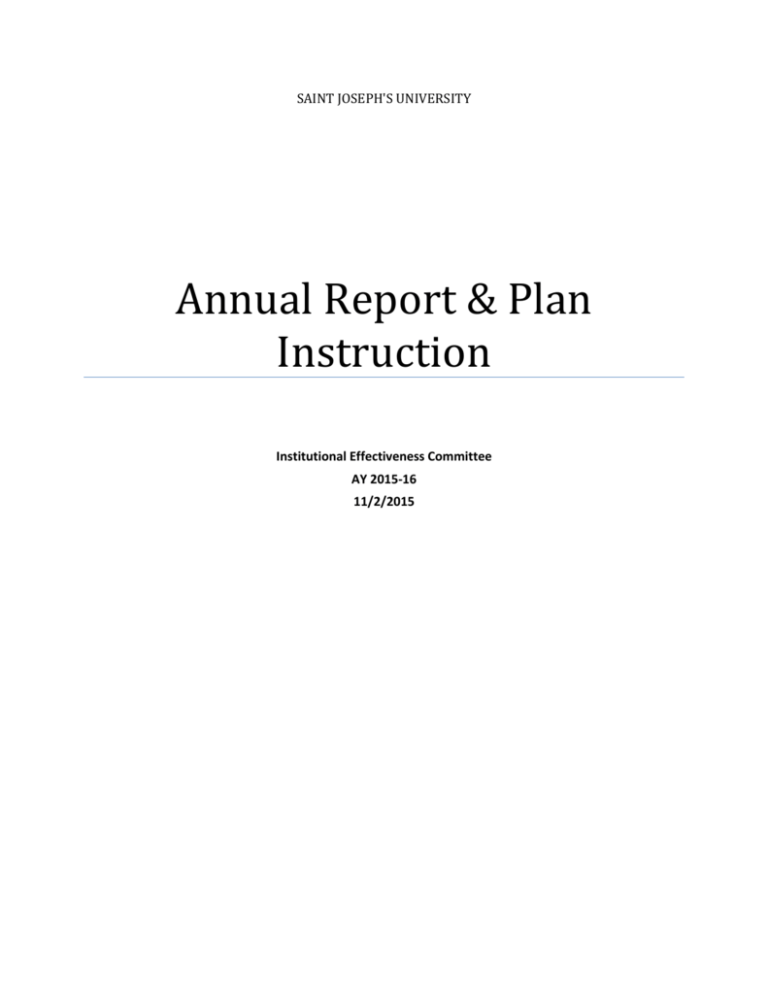
SAINT JOSEPH'S UNIVERSITY Annual Report & Plan Instruction Institutional Effectiveness Committee AY 2015-16 11/2/2015 Department/Program Annual Report Instruction Reporting Overview Each year, departments/programs are required to complete their Annual Report, Annual Plan. These reports are due to the Dean and the divisional Vice President or Provost by June 15. These reports are used to demonstrate compliance with requirements of our accrediting body and to ensure department/program activities are aligned with institutional mission, goals and objectives. Additionally, academic program/major also needs to complete the Student Learning Outcome Assessment Report which identifies the effectiveness of programs/activities in achieving desired student learning outcomes. (See SJU Academic SLO Assessment Report Template Instruction for detail) Annual Report/Annual Plan The Annual Report (Template page 1-3) is the tool for informing senior leadership of progress toward current goals. The Annual Plan provides information on department/program goals and objectives for the coming years. Instructions for each section of the Annual Report and Annual Plan are provided below. Department/Program Annual Report should be completed by both academic programs and non-academic units following the instruction in Assessment Cycle Timeline and submitted to their deans, vice presidents and IEC. To submit your report to IEC, please send the final report before June 15, 2015 to Wenjun Chi, the Assistant Provost for Institutional Effectiveness and Research by emailing wchi@sju.edu. This report template is used to replace the previous annual reports and summary reports as identified in Request for Annual Report Memo and academic assessment reports completed by units and programs in AY 2014-15. Reference: Kean University Residential Student Services 2013-14 Assessment Report Department/Program Mission and Vision Department/program mission (vision is optional) should support SJU mission and vision. If a department doesn’t have a mission yet, please use the mission of the division or college for the current fiscal year 2016. All departments/programs are expected to have a mission statement for FY2017 reporting. Reference: How to Write a Program Mission Statement (UCONN.EDU) 1 Goals and objectives: Programs and units can use the same goals and objectives identified in 2015-16 annual plan submitted on June 15, 2015. It is recommended that programs and units list no more than four goals and two objectives under each goal. Your goals may be the same over consecutive years while objectives might be different each year. Goals should be aligned with the university strategic planning goals Achieving Magis. To link your goals with relevant strategic planning goals, please click the checkbox after each goal. If your goal support more than one strategic planning goals, simply copy and paste the drop-down list to add additional goals. (Manually type in the SP code if you are Mac users) Example: Goal 1 The Residential Student Services will develop a residential atmosphere that supports university academic and retention initiatives by further expanding ACCESS tutoring services, identifying and supporting at-risk students, and creating intentional programs that incorporate both social and academic components. Supports: SP1 Academic Excellence and Transformative Student Experience Additionally, unit/program goals should be aligned with college or division strategic plan goals or priorities if applicable. Objective Reference: A good objective should be Specific (Target a specific area for improvement, Measurable (quantify or at least suggest an indicator of progress), Assignable (specify who will do it), Realistic (state what results can realistically be achieved, given available resources), and Time-related (specify when the result(s) can be achieved). (Doran, G. T. (1981). "There's a S.M.A.R.T. way to write management's goals and objectives". Management Review (AMA FORUM) 70 (11): 35–36) Saint Joseph's University is required by Middle States Commission on Higher Education to provide “clear and measurable outcomes” in assessment process (Progress Report due Oct 1st, 2016). Responsible Unit and/or Individual The unit or person ultimately responsible for meeting the objective and delivering results. Measurement Strategy Please explain the measurement strategies and the tools you used including models and the system/software such as Campus lab, Blackboard, Survey Monkey, Qualtrics etc. 2 Assessment Result Indicate your assessment result including achievement and challenges. Include the connection with the assessment result from previous years if applicable. Action Plan/Cost Estimate/Resource Reallocation Plan: If there is action and resource reallocation to be taken based on the assessment result, please indicate the action plan in detail. Your action should be made based on the assessment results and it should support the long term and short term direction of your department and the mission of the college. For academic units: action plan or resource reallocation may include changes on workshop, professional development, course assessment and evaluation, usage of physical facilities, academic advising, curriculum development etc. and it should be related with the departmental objectives. For administrative units, the planning and resource reallocation may include changes on labor, tools and equipment, technology, services and projects, and should be driven by strategic plan and division priorities. If the action is cost related, please indicate the amount and the funding resource, timeline, plan and the influence on the unit, college/division or institution. Department/Program Annual Plan (Template page 4-5) Your goals can be the same over the years, depends on the measurement you choose and results you collected, and the priority of your college, division and the institution. 3 Preliminary Plan for the Next Fiscal Year All academic and non-academic units should complete this table (Template page 6) and submit it to their deans or division vice presidents following the instruction in Assessment Cycle Timeline. Review your annual report and identify the top three to five resource reallocation priorities for the next fiscal year (e.g. FY2018) that require decision making on college and institutional level and are based on assessment results. The decision should be made through group discussion on your unit/program priorities, the college/division priorities and the related strategic plan goals your plan support. Add additional page(s) or link(s) for more detail if needed. (e.g. a business plan, assessment result, etc.) Examples of typical capital items are: New equipment, furniture, construction in excess of $5,000. Examples of typical salary resources are: Salary and benefits (HR should be contacted for this information) Examples of typical non-salary resources are: Additional utility expense, maintenance expense. Annual Report Evaluation Table This table (Template page 7) will be completed by the IEC for all academic and non-academic units. Programs and units should review this evaluation for self-improvement before submitting your report. 4 Definition Strategic Planning Goals (Achieving Magis) SP1: Academic Excellence and Transformative Student Experience SP2: Community Engagement SP3: Campus Culture SP4: Financial Strength GENERAL EDUCATION STUDENT LEARNING OUTCOMES GEO1: Demonstrate foundational knowledge of Western Civilization and its dynamic interactions with other cultures. GEO2: Think critically, conduct inquiry, analyze problems qualitatively or quantitatively and formulate creative responses. GEO3: Communicate effectively GEO4: Reflect critically on their own beliefs and values as well as those of others and to discuss respectfully religious, social, and cultural difference. GEO5: Demonstrate an understanding of the relationship of faith and reason from different theoretical perspectives. GEO6: Understand and employ a theoretically informed ethical perspective, which provides the foundation for a transforming commitment to social justice, animated by belief in the dignity and freedom of the human person. GEO7: Analyze individual, institutional, and societal behavior. GEO8: Understand and employ important concepts and methods in mathematics. GEO9: Understand the scientific worldview and apply methods of scientific inquiry. GE10: Appreciate beauty and creativity in their various forms. 5







